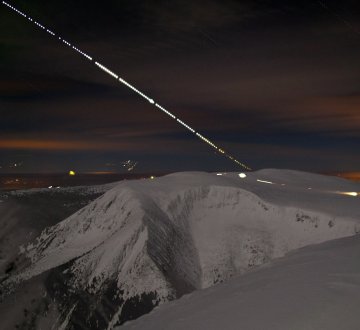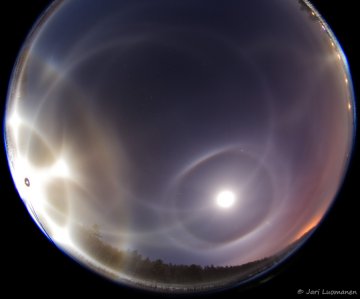| AURORA ALERT: Did you sleep through the Northern Lights? Next time get a wake-up call: Spaceweather PHONE. | | | AURORA WATCH: A solar wind stream is heading toward Earth, due to arrive on Jan. 17th or 18th. High-latitude sky watchers should be alert for auroras. HOURS OF VENUS: Today, Jan. 14th, Venus reaches its maximum elongation (greatest apparent distance) from the sun. Go outside at sunset, face south, and take a long look. Venus won't set for more than three hours. Lukas Ronge sends this photo of the planet's leisurely descent over Snezka, the tallest mountain in the Czech Republic: 
"This is a stack of 150 images captured by a webcam located at Snezka's snowy peak," says Ronge. "The exposures were taken at one minute intervals." If you have a telescope, take advantage of the extra time to inspect Venus through the eyepiece. The view may surprise you: Venus is just half a planet! Like the Moon, Venus has phases, and at the moment the phase is near 50%. In Germany, Torsten Hansen photographed the dichotomy using an 8-inch Newtonian: photo. more images: from Ugur Ikizler of Mudanya - Bursa / Turkey; from Wienie van der Oord of Eilat, Israel; from Marko of Stojnci, Slovenia; FANTASTIC ICE HALOS: Night falls. You grab your halogen lamp and step outside into the moonlight. A bitter arctic wind tries to push you back; ice crystals sting your eyes. But what you see overhead carries you forward into the night: 
"Jari Luomanen and Marko Riikonen braved the intense cold of the Finland night on January 9/10 to research halos and obtain this stunning shot showing halos from the Moon competing with those from a halogen lamp," explains atmospheric optics expert Les Cowley. "Lamps plus crystals from snow-making machines are the latest way to study ice halos: details. Here the lamp is acting as the equivalent of a low sun to create a whole set of rare arcs such as the Hastings and helic previously seen only in Antactica." Luomanen has video-recorded the manmade halos shimmering and flashing in the night. Click here for a 6 MB snippet or visit his web site to view full-length 50+ MB reels. It's the next best thing to being there.
Comet Lulin Photo Gallery
[sky map] [Comet Hunter Telescope] | 
